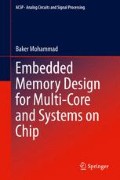Abstract
Embedded memories are becoming an increasingly important part of processor and system-on-chip (SOC) because of their positive impact on performance. However, embedded memories can negatively impact area, power, timing, yield, and design time. The ever-increasing gap between processor frequencies and DRAM access times, popularly referred to as memory wall, has indicated that processors use more and more on-die memory, hence the name “Embedded memory” [1, 2]. In addition, the new paradigm of multi-core systems and multi-functional units on the same die driven by the need for power efficiency, multi-functioning and large data size for high performance also contributes to the increase of embedded memory size [3]. As a result, in many chips the memory arrays make-up more than 80 % of the device and occupy about half of the chip’s area [4]. Figure 1.1 shows an example of the embedded memory size trend of the Intel mobile processor [5].
Access this chapter
Tax calculation will be finalised at checkout
Purchases are for personal use only
References
Wilkes, M. The memory gap and the future of high performance memories, ACM Computer Architecture News, vol. 29, March 2001, pp. 2–7.
Weste, N. and Harris, D. CMOS VLSI Design: A Circuits and Systems Perspective, Addison-Wesley, 2005.
Wulf, W.; McKee, S. Hitting the memory wall: Implications of the obvious, ACM Computer Architecture News, March 1995, pp. 20–24.
G. Gerosa, S. Curtis, M. D’Addeo, B. J. B. Jiang, B. Kuttanna, F. Merchant, B. Patel, M. Taufique, and H. Samarchi, A Sub-1W to 2W Low-Power IA Processor for Mobile Internet Devices and Ultra-Mobile PCs in 45nm Hi-k metal Gate CMOS. 2008.
Hennessy, J. and Patterson, D. Computer Organization & Design, 3rd ed., Morgan Kaufmann 2005.
Handy, J.; The Cache Memory book; Academic Press; San Diego; CA 1998.
Hidaka, H. Evolution of embedded flash memory technology for MCU, IEEE IC Design & Technology (ICICDT), May 2011; pp. 1–4.
Rabaey, J.; Chandrakasan A.; Nikolic B.; Digital Integrated Circuits (2nd Edition), Jan 2003.
H.-T. Lin, Y.-L. Chuang, and T.-Y. Ho, Pulsed-latch-based clock tree migration for dynamic power reduction. IEEE, 2011, pp. 39–44.
E. Terzioglu, S. S. Yoon, C. Jung, R. Chaba, V. Boynapalli, M. Abu-Rahma, J. Wang, S. Yang, G. Nallapati, A. Thean, C. Chidambaram, M. Han, G. Yeap, and M. Sani, Low power embedded memory design process to system level considerations. IEEE, 2011, pp. 1–4.
Fetzer, ES. et. al, A fully bypass six-issue integer datapath and register file on the intanium-2 microprocessor, IEEE J. Solid State Circuits, volume 37, November 2002, pp.1433–1440.
Arm microprocessors http://infocenter.arm.com/.
Borkar S. et al. Parameter variation and impact on circuits and microarchitecture, in Proc. of DAC, 2003, pp. 338–342.
J. Bhavnagarwala et al. The impact of intrinsic device fluctuations on CMOS SRAM cell stability, IEEE J. Solid-State Circuits, volume 36, April 2001, pp. 658–665.
R. Kapre, K. Shakeri, H. Puchner, J. Tandigan, T. Nigam, K. Jang, M. V. R. Reddy, S. Lakshminarayanan, D. Sajoto, and M. Whately, SRAM Variability and Supply Voltage Scaling Challenges. IEEE, 2007, pp. 782–787.
Warnock, J.; Chan, Y.H.; Harrer, H.; Rude, D.; Puri, R.; Carey, S.; Salem, G.; Mayer, G.; Yiu-Hing Chan; Mayo, M.; Jatkowski, A.; Strevig, G.; Sigal, L.; Datta, A.; Gattiker, A.; Bansal, A.; Malone, D.; Strach, T.; Huajun Wen; Pak-Kin Mak; Chung-Lung Shum; Plass, D.; Webb, C. 5.5GHz system z microprocessor and multi-chip module, Solid-State Circuits Conference Digest of Technical Papers (ISSCC), 2013 IEEE International
M. Zwerg, A. Baumann, R. Kuhn, M. Arnold, R. Nerlich, M. Herzog, R. Ledwa, C. Sichert, V. Rzehak, P. Thanigai, and B. O. Eversmann, An 82A/MHz microcontroller with embedded FeRAM for energy-harvesting applications. IEEE, 2011, pp. 334–336.
Author information
Authors and Affiliations
Rights and permissions
Copyright information
© 2014 Springer Science+Business Media New York
About this chapter
Cite this chapter
Mohammad, B. (2014). Introduction. In: Embedded Memory Design for Multi-Core and Systems on Chip. Analog Circuits and Signal Processing, vol 116. Springer, New York, NY. https://doi.org/10.1007/978-1-4614-8881-1_1
Download citation
DOI: https://doi.org/10.1007/978-1-4614-8881-1_1
Published:
Publisher Name: Springer, New York, NY
Print ISBN: 978-1-4614-8880-4
Online ISBN: 978-1-4614-8881-1
eBook Packages: EngineeringEngineering (R0)

